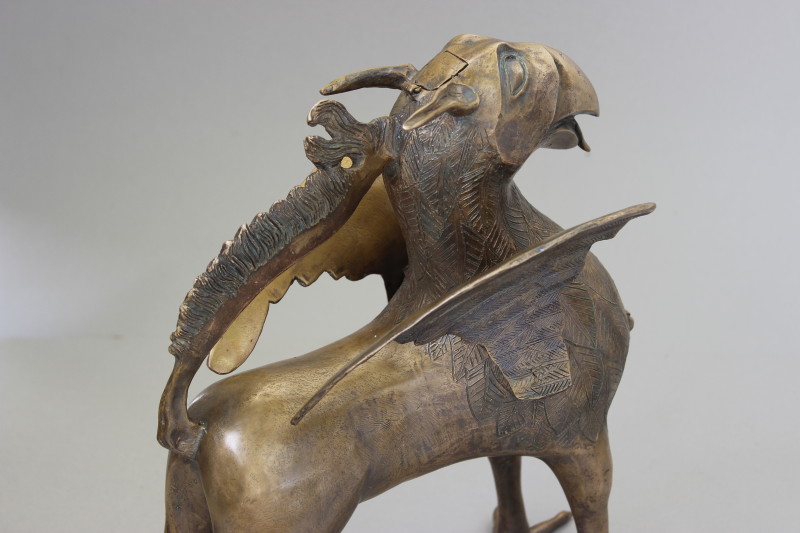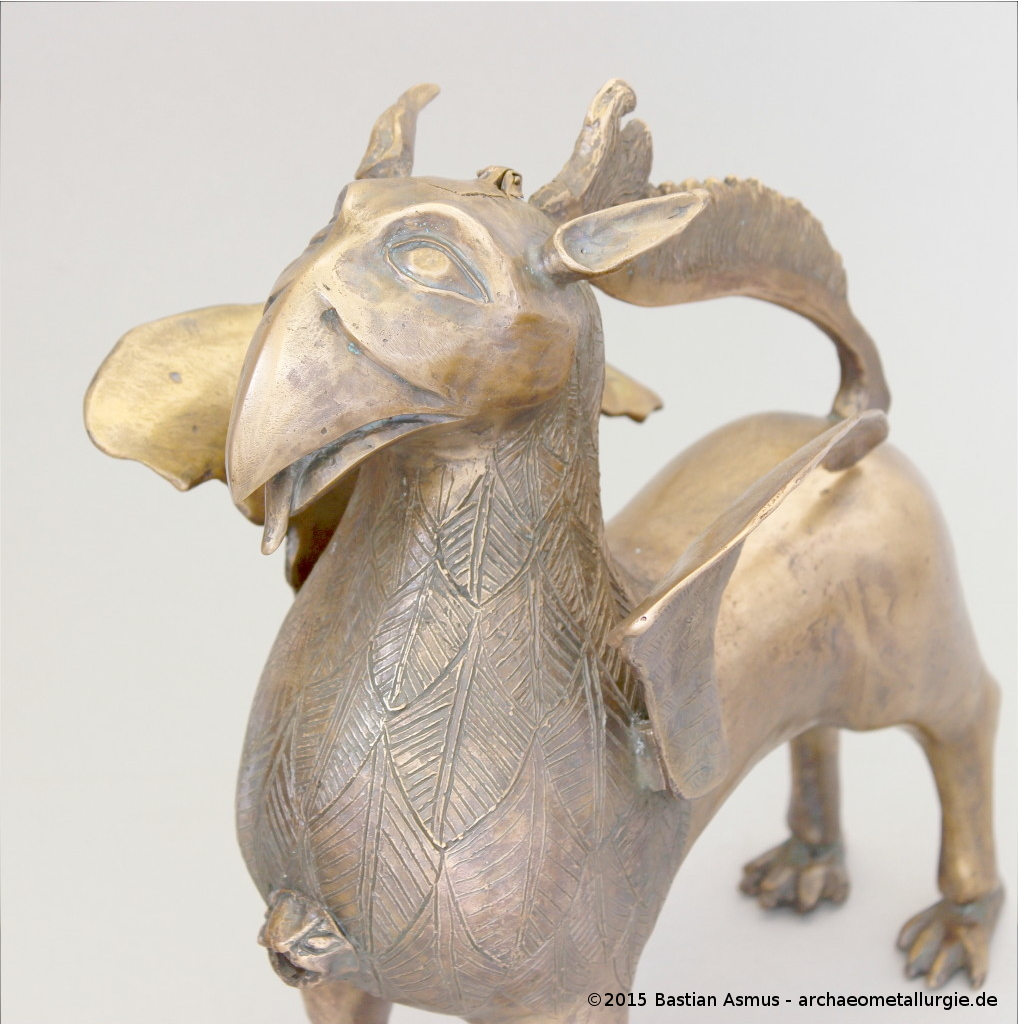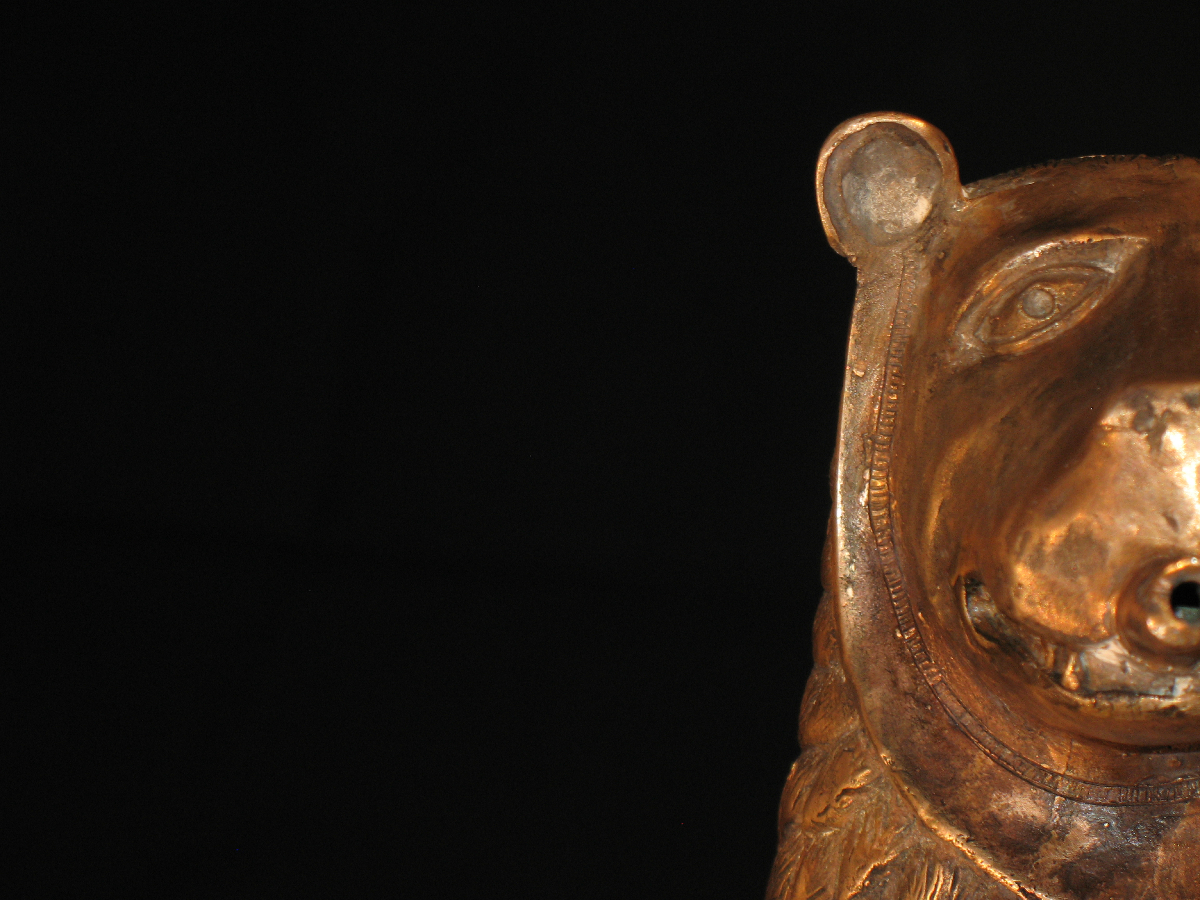May
21
2015
Bastian Asmus

Aquamanile in the form of a griffin. The original is from a 15th century Nuremberg Rotschmied workshop. The pictured aquamanile was modelled by Ragna Asmus and cast by Bastian Asmus.
A griffin aquamanile made some 600 years later
I realise that I have been somewhat negligent over the past three to four months when it comes to writing. I was immersed in the most fascinating and satisfying work in the past four months, however and simply did not have time to write. Within the next few weeks I will post about the 12th to 15th century bronze and brass objects I was commissioned to reconstruct. Let us begin with my favorite piece today: The griffin aquamanile that is now housed in the Metropolitan Museum in New York.
This bronze aquamanile in the form of a griffin was cast in early 2015 and can be viewed from 30 May 2015, the newly established European Hanseatic League Museum. The Griffin was modelled by Ragna Asmus after a griffin aquamanile that was made in Nurmeberg between 1425 and 1450. It is significantly younger than the lion aquamanile I have made two years previously. In the 15th century Nuremberg was a leading centre of the brass and brass-ware production and had surpassed the importance Dinant held in the 12th and 13th centuries. From the 14th century the production of “Dinanderie” shifted from Dinant and the Meuse region to Nuremberg. After Dinant’s destruction in 1466 the metal trades in Nuremberg became an even more important one than Dinant ever was . The numerous professions in the Rotschmiedehandwerk may be seen as an evidence of this upsurge in productivity.
This aquamanile was completely remodelled in bee’s wax and cast in the lost wax process.

Aquamanile in the form of a griffin.
Literature
{1698736:W32WVGS7},{1698736:TIIAPF7E};{1698736:W32WVGS7},{1698736:TIIAPF7E}
harvard1
default
asc
0
2689
no comments | tags: Aquamanile, aquamanilia, casting, Nuremberg, practical archaeometallurgy, Renaissance, Rotgießer, Rothschmied | posted in Aquamanile, Archaeometallurgy, General, Metal casting, practical metallurgy, Reconstructions
Jun
27
2013
Bastian Asmus
 A lion aquamanile from Halberstadt, Germany
A lion aquamanile from Halberstadt, Germany

The lion aquamanile you can see here I modelled after the aquamanile from Halberstadt. It is to date one of the very few aquamaniles that is still in its original context (Mende 2008). Aquamaniles, somtimes also referred to asaquamanale, aquimanile, aquamnilia is composed of the the two latin words aqua, for waterr und manus, for hand. The term aquamanile was used differently in medieval times than today: it mostly referred to the receptables of the water in the form of dishes or bowl. In contrast the vessel for pouring water was called urceus, i.e. latin for ewer (Wolter-von dem Knesebeck 2008, 217). Aquamaniles were used for the ritual cleansing of the priest before the mass. Apart from this ecclesiastic use aquamaniles were also to be found in secular households of high social status where they were used before meals.

Detail shot of the wax model
During the last month or so I modelled this 13th century aquamanile and cast it in bronze in my casting workshop using the lost wax technique. The model was made from wax and was prepared over a core of loam, just as it was described by the benedictine monk and artificer Theophilus Presbyter in his schedula diversarum artium in the chapter on the production of the cast incense burner. See here how the article on the casting of the aquamanile went in the reconstructed medieval loam mould.
To this end wax plates were applied to the loam core. This is also described by Theophilus. An alternative way to produce a wax layer of sufficient thickness would have been the repeated dipping into liquid wax. This however was not mentioned by Theophilus and therefore not used. After the wax plates had been applied the finer details, such as the mane or the eyes of the lion were shaped.

Detail shot of the aquamaniles face
The aquamanile weighs 3,6 kg and holds 1.35 l of water. This reconstructed aquamanile may be seen in its original function at the events of the french re-enactment project Fief et chevalerie. Contact me if you would like to purchase this or any other aquamanile.
References:
Ursula Mende 2008.
Catalogue entry 52 in: Michael Brandt (Hrsg), Bild & Bestie. Hildesheimer Bronze der Stauferzeit. 378p. 2008.
Harald Wolter-von dem Knesebeck 2008.
Zur Inszenierung und Bedeutung von Aquamanilien, in: Michael Brandt (Hrsg), Bild & Bestie. Hildesheimer Bronze der Stauferzeit. 2008.
Medi bronze aquamanile in the form of a lion
Image 1 of 7
Dies ist eine Neuschöpfung des mittelalterlichen bronzenen Löwenaquamaniles von Halberstadt.
Das Original ist im Halberstädter Dommuseum.
This is a lion aquamanile that was made after the medi bronze aquamanile of Halberstadt. The original is in the Halberstädter Dommuseum.
2 comments | tags: Aquamanile, aquamanilia | posted in Aquamanile, Archaeometallurgy, General, Metal casting, practical metallurgy, Reconstructions





